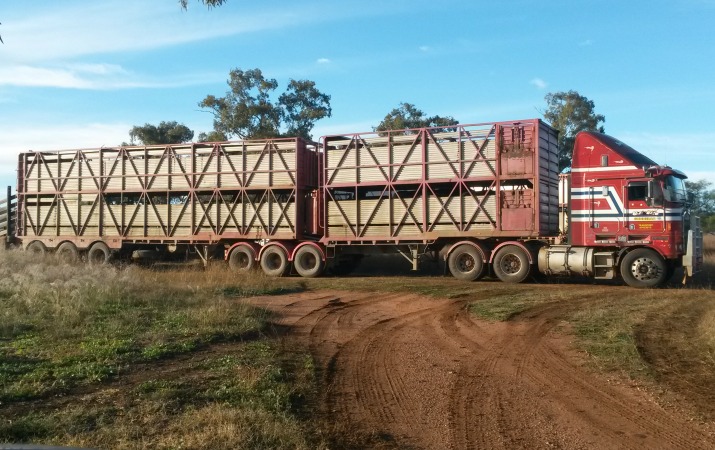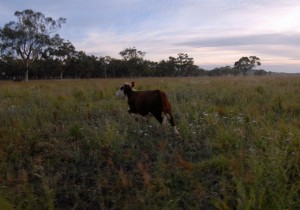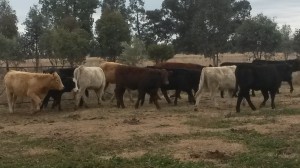I’ve talked quite a bit about land management in previous blogs, but being a ‘conscious’ farmer to me is about also treating our livestock well. This is important for the welfare of the animals, but also because whatever is good for the animals is also good for productivity, meat quality and carcase yield. Not to mention that it also makes a day mustering, or in the yards a much more pleasant experience! It would seem like madness to spend our efforts on the right pastures and genetics for optimising weight gains, to then send stock off to market and lose an unnecessary amount of this to shrink as a result of poor handling.
I think I’d be fair in saying that with Low Stress Stockhandling it’s one in, all in. So, after my husband Derek attended a school about 5 years ago, it was not long after that his father and I then went on to upskill too! We’ve been practicing it ever since. I’d like to share with you the great impact that this can have on your herd, as well as the principles behind practicing it. For any of you who have previously trained in this area, I hope you enjoy a re-cap (as I have also done in writing this blog). For those of you that haven’t, I hope it gives you a taste for what is possible. I strongly encourage attending a course, as no amount of writing can truly convey what the hands on learning can.
I also had a chat with Low Stress Stockhandling founder Jim Lindsay, to get an update on whether anything had been updated or changed since I had attended training.
One of the important things to remember about low stress stockhandling, is that it is NOT about NO stress, it is about LOW stress, and low stress is even perhaps better expressed as appropriate pressure.
Attitude
If there is something to be learned from Low Stress Stockhandling it is the motto of those that teach it, and that is that “Attitude is Everything”. Our attitude determines how our day will run.
Our thoughts become our attitude, our attitude becomes our actions, and our actions become our reality.
(I believe what is actually reflected by the term attitude is our ‘energy’. When we understand the energy of our thoughts, our livestock, our soils, our plants and our farming systems we will have the next big shift in how farming is done – but that’s for another day’s discussion. For now let’s stick with attitude).
Attitude includes being aware and careful of the language we use. For example, there may be a better use of words than ‘running’ your livestock into the yards.
Education
When practicing the handling techniques, we are not just handling the livestock in a certain fashion; we are also educating them in the process. We are not only changing the way that we handle them, but we are changing the way that they react to us.
Before I go into the principles of handling livestock, remember that the intention is to work with the basic animal instincts. These are:
- “Animals want to move in the direction they are facing.
- Herding animals want to follow other animals
- Animals want to see what is pressuring them
- Animals want to have pressure released.”
These principles apply to either open paddock stockwork or to working with livestock in the yards. It also doesn’t matter whether we are working stock on a bike, on foot, on horseback or in a ute– the principles are the same. There are 7 basic principles to Low Stress Stockhandling.
The 7 principles to Low Stress Stockhandling
1. The Flight zone is the region in which pressure causes an animal to react
The first thing to realise is that all animals have a flight zone. You might consider it their personal space. We know ourselves, if someone we don’t know very well stands quite close to us, it can make us feel a bit uncomfortable (which is a mild stress), can’t it? That’s because they’re in our personal space. Livestock are just the same, but with livestock it might be called their flight zone. When we get within this ‘flight zone’ this is putting pressure (stress) on the animal and it will cause the animal to react.
Remember that it is OK to be in this flight zone and put pressure on – it is just recognising when and where this is appropriate. This is how we teach the animals to move the way want them to.
As a general rule, some species will have a bigger flight zone than others, and then within species there will be variations. Even if you haven’t practiced low stress stockhandling – you will know that some animals have a zone of only a few metres, while others have a flight zone that stretches to the other end of the paddock – which makes them difficult to manage! (And they’re not likely to perform particularly well either). The great news is that these animals with a very big flight zone can be educated to have a smaller flight zone – making them easier to manage, handle and move.
2. Body Language is the strongest form of communication with animals
Body language is extremely important with animals. We need to consciously change our body language to suit the situation and the stock. Avoid waving arms and shooing motions, but rather think about how you walk. If we were working with those animals with a bubble the size of a paddock, then we would approach them in a zig zag fashion – not walking directly at them. We would also have a low energy in our walking style. Conversely, if we had a quiet mob of cattle that are slow to move off, then an assertive, high energy walk, with an appropriate angle of approach will do the job better.
3. If constant pressure is applied to animals they will move into it.
If constant pressure is applied to an animal – it will move onto the pressure. In an open paddock situation, an animal generally has the ability to move off the pressure, by running away from it (and we don’t want animals running away). This is more relevant to an animal that is cornered or in a yard situation. Where there is no ability for the animal to move off the pressure, such as in a yard situation (especially where an animal’s flight zone may be bigger than the yard size) an animal will turn and move onto the pressure, and that’s not a good outcome for anyone!
4. When pressure is applied it must be released.
When we apply pressure to an animal it must also then be released. This may happen as the animal moves off from us, or by us moving away from the animal.
5. Every mob needs a leader
As mentioned earlier, we are utilising the natural movement of the livestock, and part of this is recognising that there will always be a leader in a mob. If we remove this leader, there will be the next dominant animal that will then become the leader. We are always making use of a leader when moving a mob. Given that herding animals like to follow other animals, if we can work well with a leading animal, then we are off to a good start.
When moving stock some distance, this may mean moving to the front of a mob to block the leader and slow the mob down that it will be kept as one and you can maintain contact with the animals at the front of the group.
We can also use the leaders to our advantage, by knowing if we split a mob to get through a gateway so we can get out in front of a mob to block them – the rest will likely follow through, despite having been cut off. This is due to their instinct to follow.
6. Position determines reaction
The field of view from an animal’s eye can be divided into three areas:
- The front third – the retard area. If we get ourselves in this zone, we will slow or stop the animal.
- Middle third – the drift area. From the drift area, we can move into either the retard or the push area.
- Back third – push area. This is the area where we can apply the correct pressure and the animal will move forward.
Animals like to see where the pressure is coming from. So if the pressure is completely outside these sight zones (and they can’t see it), an animal may turn around to see where the pressure is coming from.
7. Observation of the animals will tell you where you need to be.
By watching the animal closely, we can get an idea of how the animal is reacting to us and what we might need to do or change. One important observation to make upon leaving animals in a paddock is determining if they are settled. I will talk about this more in an example with our cattle.
Jim Lindsay advocates bringing these principles together and coming back to basics to determine what we should be doing with our livestock at any particular time. If stock aren’t moving the way we want them to, then we haven’t taught them to do one of three things:
- Block up
- To hold
- To move straight off pressure.
If stock aren’t moving the way we want them to – the problem lies with us. We need to ask, what can I change to make things work?
Why Low Stress Stock handling?
In speaking with Jim, I was keen for a measured scenario to convey to you the impact that handling animals in this way can have. Jim gave me this example from a station in the Northern Territory of Australia; it is a large place that runs around 40,000 cattle. They worked out that by using the low stress stock handling methods, they were saving at least 3.25% shrink on an 8-900km trip to these animal’s destination. With a consignment of heifers that were roughly 350kg, this was over 11kg per head. With that class of stock at $1.80/kg at the time, and the actual weights of the animals it averaged out at over $20 per head. This particular consignment was around 3000 head – equating to a saving of $62,000!
This is without considering the impact of weight gains in the paddock, joining rates or the level of enjoyment of those working the stock.
I know the advantages of this method of stockhandling, but am constantly still amazed when I hear specific examples. Here is another example from weaning time. The cattle breeder I’m referring to usually had a 10% drop in the weight of his weaners for the first month following weaning each year. This grazier employed 4 people at $200 each for 5 days at weaning to practice the low stress stockhandling techniques to educate his weaners. The outcome of this particular year was a 5% gain in liveweight in the month after weaning. This equalled a 45kg/hd advantage over the pre low stress stockhandling weaning losses. With prices at $1.60/kg at the time, over the 950 head that the farmer owned, this left the farmer $68,400 ahead – minus the $4,000 investment in the handling. What a fantastic outcome and worthwhile exercise.
Whilst we haven’t actively measured differences with our cattle here at home, we have much anecdotal evidence of the benefits. I will share with you some of the differences we have noticed and some specific examples of what we have done in a fortnight’s time, including potential handling traps for rotational graziers, inducting cattle and weaning.
What the low stress stockhandling school also made me realise is that while certain yard designs are better and safer than others, we don’t need to spend lots of money on particularly fancy yard designs that force the movement of stock particular directions. We just need to have yards that allow us to handle the cattle using their natural flow and instincts and practicing the low stress stockhandling principles.
So, it doesn’t matter if it’s bikes, horses or dogs or on foot that we are working livestock with – the same principles apply. There is more to Low Stress Stockhandling than I have mentioned, (like working the ‘T’ and optimal times of day for moving stock), which are best left to hearing about at a hands on school, which combines the theory with practical application. I hope however that I have helped you to realise the importance of conscious stock handling and that I might have helped you identify ways that you could improve yours.
Thanks to Jim Lindsay and the guys from Low Stress Stockhandling for allowing me to share this information with you.




I attended the Low Stress course about 8 years ago and thought it was a very practical course. Not only did it reduce the stress on the cattle but for myself as well. I realised that whenever the stock ‘played up’ it was in direct relation to something that I had done. I have been trading stock over the past few years and these principles have been extremely valuable in inducting the cattle to Low Stress handling and electric fencing. I found that if I didn’t induct them properly I was bound to be fixing fences the next day. Of all the courses I’ve attended over the years this has been the easiest to implement and practice.